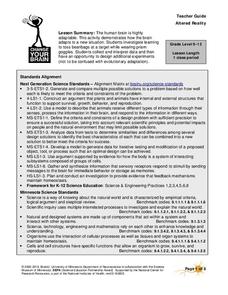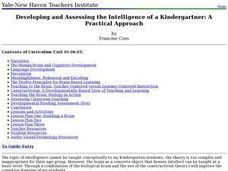University of Minnesota
Bead Neuron
What do you call a skull without neurons? A no-brainer! A hands-on activity asks scholars to build a model of a neuron using beads. They use their models to study the parts of the neuron and their functions.
University of Minnesota
Connect the Neurons!
Create a neuron frenzy as your pupils play the part of the neurons. An engaging lesson plan creates a human chain of neurons that pass cotton balls posing as neurotransmitters. Scholars learn about pre- and post-synapses as they complete...
Baylor College
Crossing the Synaptic Gap
As part of a unit on the chemistry of the brain, thinkers learn how chemicals work to transmit messages between individual neurons and how controlled substances impact the synaptic cleft. They do so by playing a dice-and-card game in...
Curated OER
Role Playing A Neuronal Transmission
Students roleplay to review nerve communication and the parts of the neuron. Each student represents a different part of a neuron and as parts become polarized and depolarized they act it out. A surprise occurs at the synaptic knob as...
University of Minnesota
Neuropathfinding: Kinesthetic Model
Playing follow the leader has never been so interesting! Get the class up and moving while they take on the roles of nervous system components. Through trial and error, they learn the importance of the "pioneer" growth cone that leads...
University of Minnesota
Dendritic Spines Lab
This is your brain on drugs ... literally! Your neuroscientists-in-training examine the evidence of drug use on the human brain and how neurons change their connectivity when altered by drugs. They then work together to create testing...
Curated OER
The Drug Connection: Design-O-Synapse
Students study cholinergic neuromuscular pathway of acetylcholine release and develop a model for drug interaction at one specific neurological site. Working in teams, students can also research different drugs or poisons and produce a...
Curated OER
NEURONS, BRAIN CHEMISTRY, AND NEUROTRANSMISSION
Learners examine the hierarchical organization of the brain, neuron, and synapse; explain the sequence of events involved in communication at the synapse; and that synaptic transmission involves neurotransmitters.
Curated OER
The Domino Effect
Students model the transmission of neural impulses with dominoes. In this nervous system activity, students construct a device with dominoes. They use the device to model the way a nerve impulse is propagated from dendrite to axon.
University of Minnesota
WebQuest: Structure of the Nervous System
What could be more natural than learning about learning? Scholars research the central nervous systems and the learning process through a well-designed WebQuest. They study the structure as well as discover the functions of those...
Curated OER
Role of Cerci in Escape Responses of the Cockroach
High schoolers investigate the changes in escape behavior in Madagascar Hissing Cockroahes when their sensory apparatus is removed. They use puffs of air at differnt angles to simulate a predator's approach then collect and analyze data...
Curated OER
Drugs Change the Way Neurons Communicate
Students examine that certain drugs interfere selectively with neurotransmission, and realize that the effect of a drug is dependent upon dosage and route of administration.
Curated OER
Nervous Tissue
In this nervous tissue worksheet, students list and describe the functions of the nervous system and its two principle parts. Then they list and give the function and location of the six types of glial cells. Students also describe two...
University of Minnesota
Altered Reality
Fascinate young life scientists by showing them how their brain learns. By using prism goggles while attempting to toss bean bags at a target, lab partners change their outlook on the world around them, producing amusing results....
Curated OER
Brain Watching
Students identify the different parts of the nervous system. In this biology lesson, students research methods to diagnose and cure neurological disorders. They present their report to class.
Curated OER
Hierarchical Organization in Biology: Students Presentations of Neurobiology
Students gather (research) information on neuron structure and action potential. Students are guided to make inferences about the synapse and its relationship to neurotransmitter release and action. They are also guided to make...
Curated OER
The Human Memory
This is a well-designed, creative instructional activity to help students learn more about the human memory. Working in pairs, students complete tasks and gather data. Excellent websites for resources are also provided.
Curated OER
'Neuro-Bingo'
Students discuss the nervous system and its pathology. They are then able to explain what neural physiology is. They use this game to further help them to develop clear meaning of the nervous system.
Curated OER
Developing and Assessing the Intelligence of a Kindergartner: A Practical Approach
Young scholars name objects that are the same size, shape, and weight as the human brain. They touch the model brain, feeling the folds, etc. They make connections to the chart displaying the brain-like objects. They touch the 'potato...
Curated OER
Response to Stimuli
Students study the process of detection, coordination and response. In this biology lesson, students design an experiment to test stimuli response. They participate in a game-show style quiz after the activity.





















